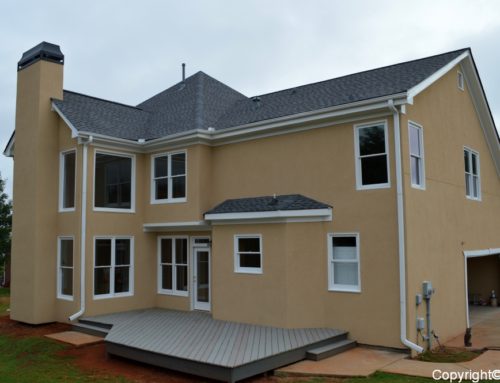Washing Your House
Most people wouldn’t buy a Mercedes and never wash it. Your home is an even larger investment, so you should consider a yearly washing of your home to remove wind- blow grime splashed soil, and other things tarnish the appearance. This can be done with a long –handled soft brush (RV washing brush), a bucket of soapy water, and a garden hose. Dish soap is fine. Do not use harsh or abrasive cleaners. If stains remain, use a little more elbow grease with the soap brush. After washing, rinse the wall with a gentle spay of water. This will go a long way toward preventing algae, mold, and mildew growth on the surface of the stucco and keeping your home looking like new.
Physical Damage
Stucco coatings are not design to be bumped by vehicles, used as reflectors for tennis practice, or to withstand other form of physical abuse. Trees and limbs should be trimmed away from the stucco coatings (for that matter, from all cladding materials), since repeated rubbing by tree limbs can erode the surface.
Water Penetration at Openings in the Wall
Most water penetration into a stucco wall occurs at an opening in the wall. This included windows, door, hose bibs, electrical outlets, etc. Each of these areas was flashed to prevent water from getting behind the weather-resistive barrier. To limit the amount of water that the flashing has to divert, each of these areas should be sealed with a quality sealant. When dissimilar materials come together, temperature fluctuation cause movement. This can cause the sealant to pull away from one of the surface and allow water behind the stucco. At least once a year, the sealant around each opening should be checked. This can easily be done when windows or the entire house is washed.
Water Penetration at Crack in Stucco
Stucco cracks. The smoother the stucco is the more apparent the cracks are. The stucco wall is designed to take any water that may be behind the stucco through these cracks and diverted it down to the base of the wall to allow it to drain. If soil is brought up to sigh on the wall, this may interfere with the draining of the stucco. Some home owners have use caulk to seal the space between the weep screed (bottom accessory on the stucco run) and the foundation. This keeps water in the wall and can lead the problems.
As long as the cracks in the stucco are minor, they are not the problem. If you cannot insert a credit card into a crack, it is minor. If a credit card can be inserted into a crack, or if one side off the crack stands out from the wall further that the other side, call your contractor to determine the cause and address the problem. Some people try to fix cracks with a bead of caulk and putty knife. This technique is not advice, since it changes the texture around the crack, which makes the crack evident from a much great distance.
Staining
Stucco can be stained by dirt splashing up on the wall, especially clay soils. It can also be stained by sprinkler heads spraying water of the wall .As the water evaporates, hard water residue can be deposited on the wall. Prevention is much easier that repair. Use a mulch or grass to cover any earth close to wall, maintain at least a 4” space between the bottom of the stucco coating and the soil, and ensure that sprinkler head do not spray on the wall .Many stains can be removed by washing your house as instructed. Occasionally, more drastic action must be taken: pressure washing tough-to-clean areas. If you elect to use a pressure washer, the pressure must be less that 1000 Psi, and the nozzle must be maintained at least 12 inches from the surface of the stucco. An inclined spray rather that a direct spray is usually more efficient. Do not spray close to windows and other openings in the wall. Do not use acids to clean the coatings.
Efflorescence
Efflorescence is an indication that water from inside the wall is dissolving minerals within the wall and coming to the surface to evaporate. While efflorescence may be seen during new construction ,any efflorescence after the wall has be in service several months may be indicate that water is getting in the wall. This may be from a roof leek, faulty gutters, or faulty sealants around openings. Check the sealants around the openings and correct any defects if the efflorescence is around or below openings. Check gutters to ensure they are not spilling water onto the stucco coating. If neither condition appears to be causing the problem, call the builder or a quality roofer to check for roof leaks.
Algae, Mold and Mildew
Algae, mold and mildew are plants of opportunity. When conditions are right, they will grow .All need moist conditions. Keeping vegetation cut back from walls will often limit the moisture on the wall and eliminate the problem. Algae need a source of minerals. This may come from soil splashing up on the wall, leaf decay blowing against the wall, or tree sap and other organic products sticking onto the wall. Mold and mildew need a source of organic matter. This can come from many of the same source from which algae gets its nutrients. Lightly pressure- washing the wall may remove the plants and their food source. Washing the wall with diluted laundry bleach (1 part bleach and 5 parts water) will often kill the plants if the wall kept damp with the mix for about 20 minutes. After 30 minutes the bleach mixtures should be rinsed from the wall.



Stay In Touch